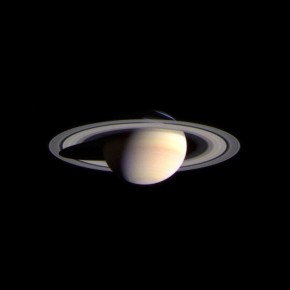By Staff Writer Cristina Deptula
Earth is not the only body in the solar system with an atmosphere, so it’s not the only place with weather! Researchers such as UC Berkeley’s Dr. Mate Adamkovics, who came out to the Chabot Museum for June’s volunteer enrichment talk, predict weather on Saturn’s moons based on astronomical observations.
Titan, Saturn’s largest moon, takes 16 days to go around the planet, and 30 years to travel around the sun. Its methane and nitrogen atmosphere also experiences temperature inversions, where at some points air is warmer higher up, as opposed to the normal pattern of cooling with increasing altitude. On Earth, this pattern means that water reaches a triple point, where it can exist as a solid, a liquid, or a gas. So, scientists speculate that Titan may have a methane cycle, like our water cycle.
Astronomer Gerard Kuiper showed through mathematics that bodies with certain masses, sizes and temperatures are likely to have atmospheres. We have observed gaseous methane on Titan, so in turn we can infer the basics of the moon’s physical properties. We also can speculate about Titan’s atmosphere based on what we see through telescopes, especially with adaptive optics technology to correct errors and ‘noise’ and produce a highly accurate view.
On Titan, ultraviolet light breaks apart hydrocarbons such as methane, which become small particles that get absorbed into other substances. (On Earth, atmospheric oxygen absorbs the UV light). Titan’s methane does absorb infrared light, so astronomers can observe infrared images of the moon and estimate localized atmospheric concentrations. Generally, they find more methane lower down, where there’s less ultraviolet scattering.
The Cassini mission confirmed much of what we predicted about Titan’s atmosphere. Also, we noticed small, variable clouds scattered throughout the sky, and fog at the south pole, where there’s a ring of high altitude land. Fog differs from clouds because it touches the ground. Water ice also exists on Titan, and astronomers can predict the rates and amounts of past rainfall from the physics of what would be required to produce the observed rock shapes on the ground. However, we don’t know when the rain occurred.
Scientists previously thought Titan might possess a large ocean of ethane, since the light hydrocarbon is stable as a liquid there. Cassini did not find this ocean, but did suggest the presence of lakes, meters thick, of liquid hydrocarbons. These lakes humidify the air around them as they cool, creating ethane clouds, such as the one at the top of the moon.
Titan possesses some interesting features, such as a squall line, a long, streaky region of arrow-shaped clouds. And sand dunes in a pattern that resembles a cat scratch, from which scientists can ascertain which way the wind blows in those regions. Dr. Adamkovics wondered aloud if researchers could send a drone to Titan, as the cold, dense atmosphere would make flight aerodynamically possible.
He closed his talk with brief remarks on Enceladus, another of Saturn’s moons. Astronomers observe plumes, streaks, and geysers emitted from Enceladus, as well as cracks within its water ice. These cracks may come from cycles caused by Jupiter’s gravitational pull, occasionally heating parts of the moon. Or, possibly from radiogenetic heating, occurring as radioactive isotopes of carbon decay – although scientists think this would have stopped by now.
Dr. Mate Adamkovics’ talk illustrated how much researchers can determine and infer about bodies in space just from a few firsthand observations. In addition to showing us the worlds of Titan and Enceladus, he demonstrated some of the tools and methods of atmospheric science, which also help to predict and understand Earth’s weather.
Cristina Deptula is a staff writer from San Leandro, California who would take a ride on Dr. Adamkovics’ airplane on Titan, if given the chance. She can be reached at cedeptula@sbcglobal.net
Oakland’s Chabot Space and Science Center’s located at 10000 Skyline Boulevard, deep within the Oakland Hills. It hosts free public telescope viewings, from 8-10 pm every Friday and Saturday evening.


Pingback: Synchronized Chaos » Blog Archive » Synchronized Chaos August 2013 – Artistic Renderings